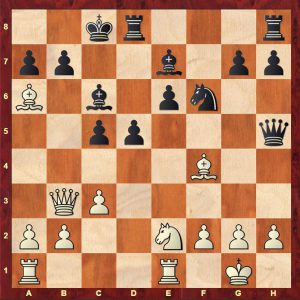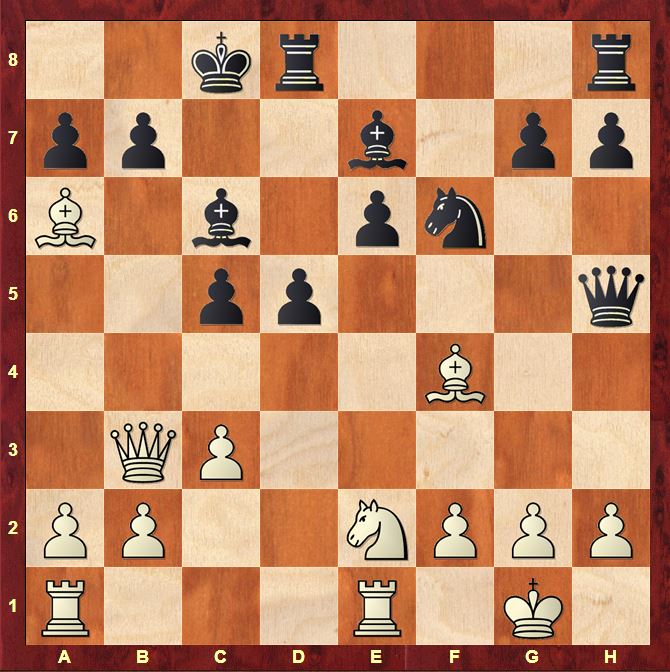I’m often asked how much I see during a game. It’s a difficult question to answer because the implicit assumption behind the question is that if you see something, you see it precisely and accurately and with a high degree of completeness. In my experience that’s not true for most of the variations you spot during a game, and in fact it isn’t even necessary.
In a practical game, the goal is to discard irrelevant lines as quickly as possible in order to dedicate the maximum of your limited time and energy to the variations most likely to arise in the game.
In complicated positions with many plausible possibilities, it can be difficult to find your bearings. When this happens, the tendency is to seek safety in numbers by calculating each of the plausible possibilities to a shallow depth (1-2 moves). My experience is that this is a prelude to confusion and exhaustion. 2 additional moves are not usually enough to clarify the worth of a specific variation, and it quickly becomes a strain to juggle a large number of indeterminate variations in your head.
In such cases, I reason that the position exceeds my calculating horizon: I will need to move the game forward a number of moves before my calculation is powerful enough to produce clear results. The dilemma of course is how to guide the game in a favourable direction while flying blind in a fog of complexity.
The technique I use is to generate variations in interesting / attractive lines and to use those to generate a plausible evaluation for these lines. The goal is to reach (in as many variations as possible) a reasonable-sounding conclusion of “That’s not dangerous – I have at least this, and probably / maybe even something better”. The lines for which you cannot reach such a conclusion are probably the lines you should examine in more detail!
An example of this came up in my last-round game at Haarlem against Dutch GM Erik van den Doel (already annotated in a previous blog posting http://matthewsadler.me.uk/lessons-from-the-masters/lessons-haarlem-2016-alekhines-prongs/)
Van den Doel,Erik – Sadler,Matthew D
Haarlem Nova College op 2016
1.e4 e6 2.d4 d5 3.Nd2 Be7 4.e5 c5 5.c3 Nc6 6.Bd3 Bd7 7.Ne2 f6 8.Nf3 fxe5 9.Nxe5 Nxe5 10.dxe5 Qc7
While Erik was pondering his next move, I started thinking about the possibility of White sacrificing the e5 pawn with 11.0–0
11.0–0 Qxe5
It is tricky to get a grip of such positions. White has not yet generated any threats for the pawn, but there are clouds gathering on the horizon: give White a couple of moves to play Re1 and Nf4, or Bf4 and Qb3 and Black will suddenly need to find an answer to concrete threats. Just to move things along in my head, I started trying to sample critical lines after White’s various options on move 12. For example, these were my plausible lines after
12.Re1 Nf6 13.Qb3
This idea popped out to me as I noticed in a flash that
13…0–0–0 14.Bf4 Qh5
14…c4 15.Bxe5 cxb3 16.axb3 a6 17.Rxa6 wins
15.Ba6 Bc6 (forced)

looked fairly scary. However, I noticed quickly thereafter that
13.Qb3 c4 14.Qxb7 Qb8
forces the exchange of queens and that after 15.Qxb8+ Rxb8 16.Bc2 e5 Black has little to fear (indeed I prefer Black slightly).
So my rapid conclusion about 12.Re1 Nf6 13.Qb3 on the basis of these lines was: “looks dangerous to keep the pawn, but I have at least 13…c4 14.Qxb7 Qb8 with a perfectly good ending”. This is by no means an exhaustive exploration of this possibility, but it’s more than enough in a practical game to allow you to move on quickly to the consideration of the next (possibly more dangerous) White continuations. Of course, if White chose this line in a game, you would have a good think after 13.Qb3 to see whether you had more than your “at least this” line!
If I have the time, I like to invest some effort after the tournament analysing the judgments I made during the game: it’s a good way to assess the quality of your intuition. One of the moments I’ve been able to analyse was the position after 11.0-0 Qxe5 12.Re1 Nf6 13. Qb3 0-0-0 14.Bf4 Qh5 15.Ba6 Bc6 (forced).

Was I right to screw up my face (mentally!) and reject this for Black, or was this a case of “looks dangerous, but isn’t”?
When I put the position onto the board, a very interesting idea hit me at once:
16.Nd4
Komodo takes a little while to spot this one
16…cxd4 17.Rxe6
Black now has 2 possibilities:
A. 17…Qe8
I thought of this idea once I’d completed my analysis of 17…Kd7. For a little while, I couldn’t see anything convincing and then all of a sudden it struck me!
18.cxd4
17…Qe8 holds Black’s position, but it doesn’t contribute anything positive. In fact, it ties up Black further by creating a pinned bishop on e7! This gives White the freedom to realise a very helpful achievement: the opening of the c-file on which the Black king currently stands
18…Kd7 19.Qh3
18…Qd7 19.Rc1 Qxe6 20.Qxb7#
18…Ne4 19.Rc1
18…bxa6 19.Qb8+ Kd7 20.Rd6+ Bxd6 21.Qxd6+ Kc8 22.Qc7#
B. 17…Kd7
The best defence to White’s threat of Rxc6
18.Rae1 Ne4
This was a tough one to break. I was again about to give up when I spotted a venomous little trick.
19.Bxb7
19…Kxe6
19…Bxb7 20.Re5 A gorgeously horrible intermezzo!
20…Qxe5 21.Qxb7+ The point! Black can’t pick up sufficient pieces for the queen 21…Ke6 22.Bxe5 wins
20.Rxe4+ Kf6
The most aggressive attempt: Black wants to take all White’s pieces!
20…Kf7 21.Bxc6 Qf5 22.Rxd4 is good for White
20…Kf5 21.Re5+
21.Be5+
21…Kf5
21…Kf7 22.Bxc6
21…Kg6 22.Bxc6 dxe4 23.Qe6+ Bf6 (23…Kg5 24.Qxe7+) 24.Bxe4+
24…Kh6 (24…Kg5 25.Bxf6+ gxf6 26.Qf5+ Kh6 27.Qxf6+ was my line. There are possibly better alternatives to 25.Bxf6+) 25.Bf4+
21…Kg5 22.h4+ Kf5 23.g4+ Kxe4 24.gxh5 Kxe5 25.Bxc6 is pretty much the same as the main line
22.g4+ Kxe4 23.gxh5
23…Kxe5
23…Bxb7 24.cxd4 does not augur well for Black: he cannot hold on to his extra material: 24…Ba6 25.Qe3+ Kf5 26.Qf4+ Ke6 27.Qg4+ Kf7 28.Qxg7+ Ke6 29.Qg4+ Kf7 30.Qf5+
24.Bxc6 is advantageous for White though Black is not completely out of it yet
After I’d analysed all this, I checked my lines with Komodo 10 and he of course came up with something I hadn’t thought of…
17.cxd4
is at least as strong as 17.Rxe6 according to Komodo which you appreciate better once you’ve seen the variation 17.Rxe6 Qe8 18.cxd4! Even here Black is curiously helpless to shore up his queenside further. Flight is the best option!
17…Kd7
17…Bd6 18.Rac1 Kd7 19.Rxc6 bxc6 20.Qb7+ Ke8 21.Rxe6+
18.Bxb7 Bxb7 19.Qxb7+ Ke8 20.Rxe6 Qf7 21.Rae1 Ne4 22.Qc6+ Kf8 23.f3
23…Qxf4 24.fxe4 Bf6 25.e5 Qxd4+ 26.Kh1 Qb6 27.Qxb6 axb6 28.exf6
is Komodo’s line. It’s a long line, but pretty forcing. It gives at least as big an advantage as 17.Rxe6 and you’ll be likely much less stressed finding the follow-up lines in this variation!



